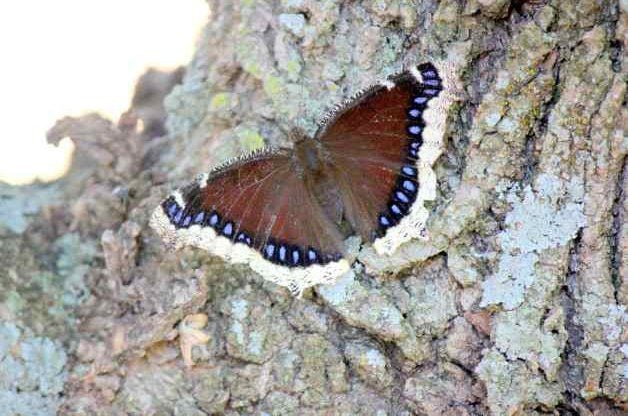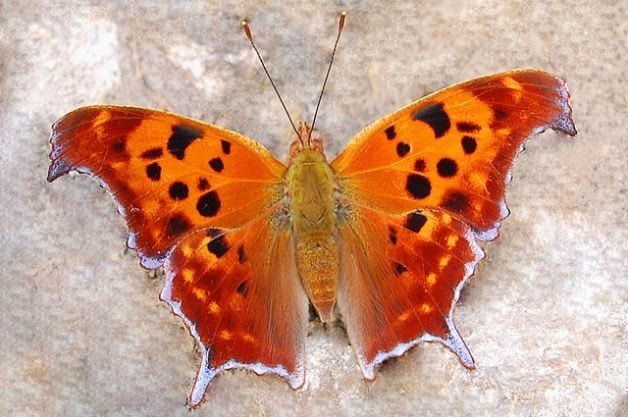Tips for Attracting the First Spring Butterflies
Updated: Jul. 13, 2020

Learn which butterflies appear first, what they feed on, and the best actions for supporting and attracting the first spring butterflies.
Robert Frost wrote of a “blue-butterfly day” in spring, when “there is more unmixed color on the wing / than flowers will show for days unless they hurry.” Perhaps Frost was spotting spring azures, one of the earliest spring butterflies to appear each year. Their tiny delicate wings are a haze of soft blue against the backdrop of newly budded trees and the fresh green of new grass. But if the flowers aren’t yet blooming, as Frost implies, what do these butterflies eat? We’ve got the answer to that question and more.
Spring Butterflies FAQ
What happens to butterflies in winter?
Some species migrate or move further south, like the famous monarch migration. But many butterflies overwinter in the same area where they spend the summer, though not always as adult butterflies. They enter a form of hibernation known as “diapause,” and special chemicals in their bodies allow them to endure extremely cold weather. Learn more about butterflies in winter here.
Some butterflies overwinter as eggs, caterpillars, or pupa, often in leaf litter at the base of trees. Others overwinter as adult butterflies, seeking out dry cracks in rocks or protected tree hollows. Those that overwinter as adults are the first to show their wings in spring; you may even see them during sunny days in winter. Butterflies that spend the winter in chrysalis are the next to appear as freshly-emerged butterflies.
How warm must it be for butterflies to fly?
Butterflies are “poikilotherms”, which is essentially like being cold-blooded: their body temperatures reflect the temperatures outdoors. Most butterflies need a body temperature of about 80 degrees F to fly, but it doesn’t need to be nearly that warm outside. Butterflies use solar energy to pump up their body temperature by as much as 20 degrees above the air temperature. So when outdoor temperatures consistently start reaching 60 degrees F or so, butterflies will begin flying.

Which butterflies appear first in spring?
This of course varies by region, but here are a few to look for as soon as days hit the 60s and 70s in your area:
- Mourning Cloaks (Nymphalis antiopa) overwinter as butterflies, and emerge as soon as the days warm up, probably looking a little tattered and worn. They can be seen across most of the country.
- Eastern Commas (Polygonia comma) and Question Marks (P. interrogationis) also overwinter as adult butterflies, emerging in early spring and laying eggs on the first new growth of nettles and elm trees.
- Cabbage Whites (Pieris rapae) and other members of this genus overwinter in chrysalis, making their appearance in early spring as newly-emerged butterflies. They’re seen around the country.
- Spring Azures (Celstrina ladon) are another butterfly species that overwinter in chrysalis and appear in early spring as newly-emerged adults. This tiny blue butterfly is found throughout the country, except in the Deep South.

Supporting and Attracting the First Spring Butterflies
Want to help out these first butterflies of spring? Here are a few simple steps to take.
Plant More Trees. Mourning cloaks and eastern commas rarely feed on flowers, instead preferring the tree sap that starts to run in late winter. They also dine on rotting fruit windfalls from the previous fall. Sugar maples and apple trees are great choices for spring butterflies. Flowering trees like redbuds are also excellent food sources.
Don’t Mow Wildflowers. The earliest native wildflowers of spring serve as nectar sources for early butterflies. Don’t be too quick to pull or mow these flowers. If you can, add more of them to your garden, sowing them the fall before so they’ll appear just in time for butterflies.
Provide Fruit and Nectar Feeders. Generally, butterflies find what they need in nature, but it’s not uncommon for some butterfly species to visit hummingbird feeders when plant nectar is scarce. You can also put out fruit like oranges and bananas, which may attract migratory birds too.
Leave Leaf Litter. Gardeners are often eager to start spring cleanup, but the longer you leave leaf litter and overgrown ornamental grasses, the better. Overwintering butterflies in all forms use these as shelter and protection.




















